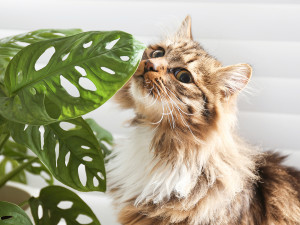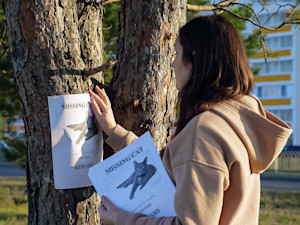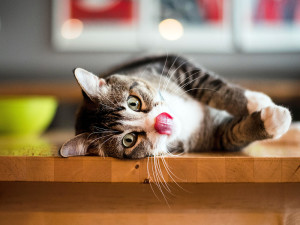How to Stop Your Cat From Munching On All of Your Precious Plants
Tips to get your cat to quit eating your greens

Share Article
Your plants are your babies. You carefully chose them, picked out the pots that would fit their size and needs, and watched as they thrived in your new flat-turned-greenhouse.
Enter: your cat, who, like your plants, continues to live in your home. You’ve done your research to make sure your plant children are not toxic to your cat – and good thing you did, because your kitty cannot stop nibbling on the peperomia plant in your windowsill.
Why does my cat eat my plants?
The answer may be unsatisfyingly simple. Wild felines regularly ingest plants, and it seems to be a behaviour that our domestic cats have inherited from their ancestors. Many cats eat plants because they enjoy the taste. Others consume plants because they are bored, stressed or attracted by the movement of the plants.
Young cats are more prone to plant-eating than older cats, which suggests that their playfulness and attempts to entertain themselves may be a part of the plant-eating puzzle. There is some evidence that cats – carnivores though they are – take an interest in plants when they need a little help with their digestion. Eating plants is not a way to expel hairballs, though many people have suggested that it is.
Can my houseplants be saved from my cat?
You’re spending so much time and effort trying to sneak kale into your morning smoothie and get your daily intake of vitamins and greens. Sadly, the only one who’s truly on board is the lone individual who shouldn’t be eating green things: the cat. Your houseplants are suffering from this feline fetish for flowers (and leaves and stems). You want to make sure your cat is safe, first and foremost, and also protect your plants.
What can be done about it?
Behaviour change always poses a challenge, and it’s almost always easier with a combination of approaches – some prevention and management, some allowing them to do what comes naturally to them in a safe way, and some active behavioural modification.
Cats can’t chew on plants they can’t reach, so making your treasured potted plants inaccessible is one part of the plan for harmony in the home. Strategically placing hanging baskets can keep those dangling leaves out of reach, for example, and so can floating shelves. In the case of plants that are truly dangerous to cats, I advise putting them in rooms the cats don’t have access to or even gifting them to cat-free friends for the safety of all. Common toxic houseplants include lilies, philodendrons, English ivy, pothos, snake plants and dieffenbachia.
Cats find plants appealing, but if we can make them unappealing, the chewing behaviour ceases. Many cats don’t care for citrus, so you can put water with lemon, lime or orange juice in low concentration in a spray bottle and spritz it on houseplants. You can also put aluminium foil around the base of the plant – a lot of cats find stepping on foil unpleasant.
Give them another option
Sometimes, the best way to avoid behavioural problems is to offer an acceptable alternative. Create a garden for your cats full of things they can consume like goblins. So, instead of telling your cat not to chew plants at all, you are giving the instruction, ‘Chew these plants, not those plants.’ Catnip, silver vine, cat thyme and rosemary are all cat-friendly plants to consider, though it’s always wise to check with your veterinarian to find out which options are best for your particular cat.
Boredom is the enemy of a well-behaved cat, so make it easy for your cat to leave the plants alone by making plenty of other options for entertainment available. Enrichment options include catios and cat trees, boxes to use as tunnels, and food puzzles. Playful cats often love the motion of the leaves and vines of houseplants, so offering opportunities to play in other ways – either with you or with toys on their own – often results in saving the plants.
Basically, in order to save your sweet, fragile plant babies, you just need to put in a little effort to appease your cat. Truly, what’s new?

Karen B. London, PhD, CAAB, CPDT-KA
Karen B. London, Ph.D., is a Certified Applied Animal Behaviorist and Certified Professional Dog Trainer who specializes in working with dogs with serious behavioral issues, including aggression, and has also trained other animals including cats, birds, snakes, and insects.
Related articles
![]()
What to Do If Your Cat Goes Missing
Cats might be curious creatures, but when yours goes missing it can send the most composed pet parent into a spin
![Curled up tabby cat sleeping on pillows]()
How Many Cat Naps Is Too Many?
A very sleepy kitty isn’t usually a problem, but watch out for these signs of medical distress
![A kitten playing with a mouse cat toy.]()
How to Keep Your Kitten From Making You the Toy at Playtime
Your cat deserves to play, but you deserve to walk away unscathed
![Cat laying inside a cat tree]()
Cat Trees That Won’t Clash With Your Aesthetic
Stylish cat trees for every home and personality, from cartoon flowers to modernist towers
![Cat grabbing onto ledge of table and looking to the left]()
Is Your New Cat Stalking You?
Yes, they are right behind you
![Cat laying on his side with catnip around him, on the kitchen table licking his lips.]()
Can Cats Eat Catnip?
They’re definitely pulling for the answer to be an emphatic ‘yes’, but... not so fast









